height AUDI R8 SPYDER 2015 Owners Manual
[x] Cancel search | Manufacturer: AUDI, Model Year: 2015, Model line: R8 SPYDER, Model: AUDI R8 SPYDER 2015Pages: 232, PDF Size: 58.36 MB
Page 59 of 232
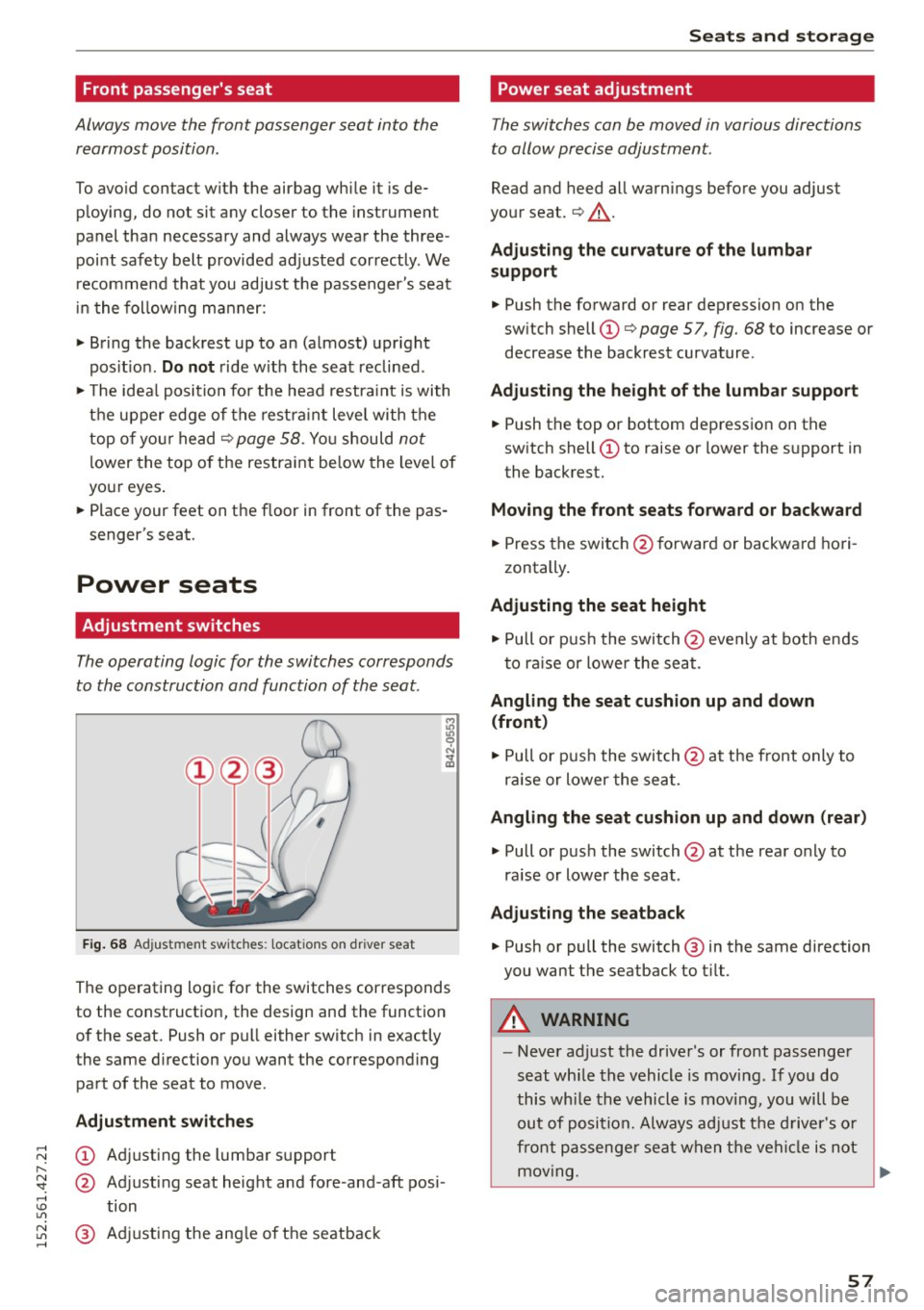
Front passenger's seat
Always move the front passenger seat into the rearmost position.
To avoid contact wit h the airbag while it is de
p loying, do not sit any closer to the instrume nt
panel than necessary and always wear the three
point safety belt provided adjusted correctly . We
recommend that you adjust the passenger's seat
i n the following manner:
"' Bring the backrest up to an (almost) upr ight
pos it ion.
Do not ride w ith the seat reclined .
"'T he idea l position fo r the head restra int is with
the upper edge of the rest ra int level with the
top o f you r head¢
page 58. Yo u should not
lower the top o f the restraint be low the level of
your eyes .
"' Place your feet on the f loor in front of the pas
senger's seat.
Power seats
Adjustment switches
The operating logic for the switches corresponds
to the construction and function of the seat.
F ig . 68 Ad just men t sw it ches: locat ions on driver seat
The operating logic for the switches corresponds
to the const ruction, the design and the function
of the seat. Push or pull either switch in exactly
the same direction you want the corresponding pa rt of the seat to move .
Adjustment switches
~ (I) Adjusting the lumbar s upport
r--
~ @ Adjusting seat height and fore-and -aft posi-,....,
S eat s and stor age
Power seat adjustment
The switches can be moved in various directions
to allow precise adjustment.
Read and heed all warnings before you adjust
your seat.¢ ,&..
Adju sting the cur vatur e of the lumbar
support
"' Push the forward or rear depression on the
sw itch shell (I)¢
page 5 7, fig. 68 to increase or
decrease the backrest curvature .
Adjusting the height of the lumbar support
"' Push the top or bottom depression on the
sw itch shell (I) to raise or lower the s upport in
the backrest.
Moving the front seat s forward or backward
"' Press the switch @forward or backwa rd hori
zontally.
Ad justing the seat height
"' Pull or pus h the switch @eve nly at both ends
t o ra ise or lowe r the sea t.
Angling the seat cushion up and down
(front )
"' Pull or pus h the switch @at t he front only to
ra ise or lower the sea t.
Angling the seat cushion up and down (rear)
"' Pull or push the switch @at the rear o nly to
ra ise or lower the seat .
Adjusting the seatback
"' Push or pull the switch @ in the same direction
you want the seatback to t ilt.
A WARNING
--- Never adjust the driver's or front passenger
seat whi le the vehicle is moving. If you do
this whi le the vehicle is moving, you will be
ou t of position. Always ad just the d river 's o r
fr ont p assenge r seat w hen t he vehi cle is not
mov ing.
~
57
Page 60 of 232
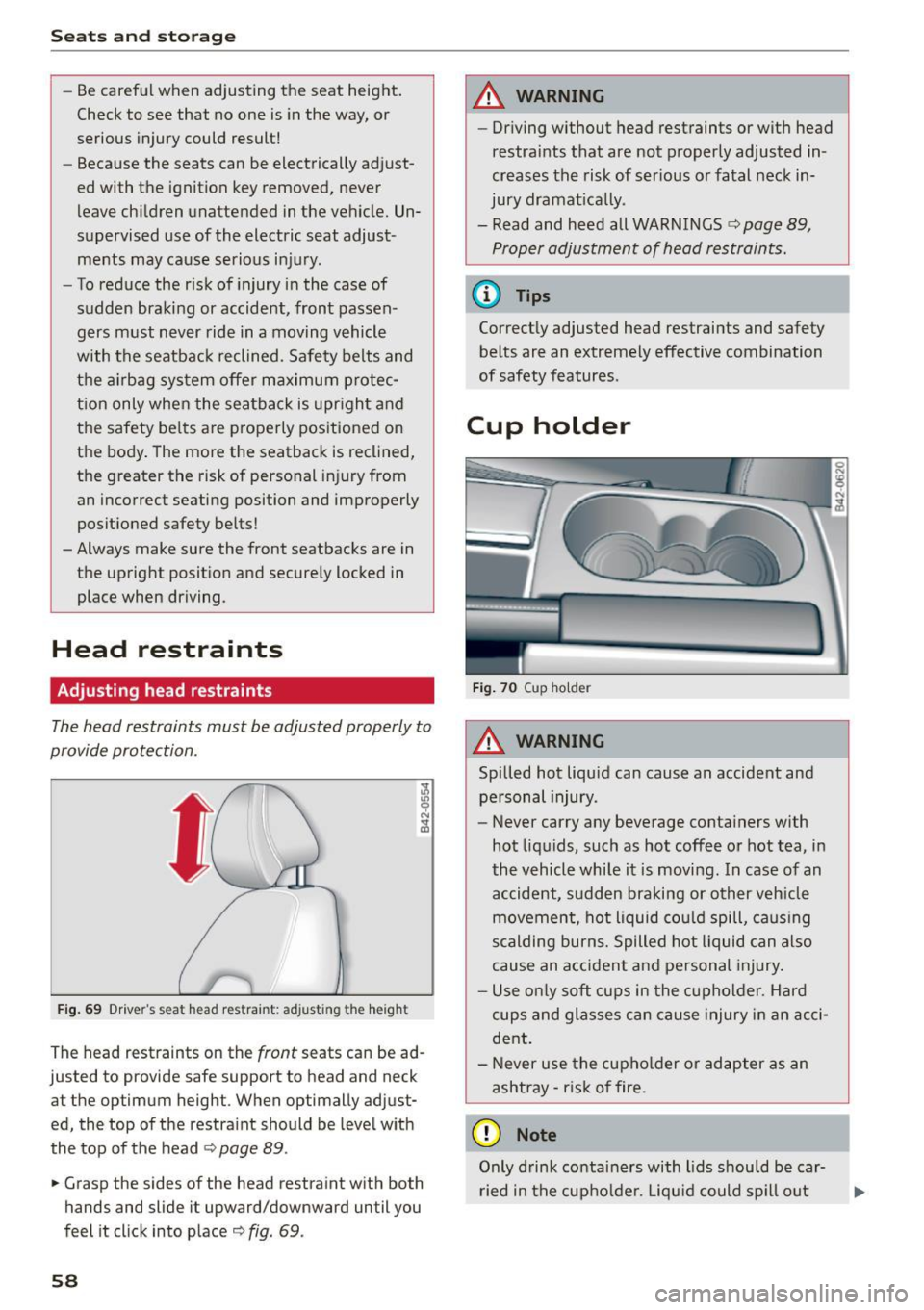
Seats and storag e
-Be careful when adjusting the seat height.
Check to see that no one is in the way, or
serious injury could result!
- Because the seats can be electrically adjust
ed with the ignition key removed, never
leave children unattended in the vehicle. Un
supervised use of the electric seat adjust
ments may cause serious inj ury.
- To reduce the r isk of injury i n the case of
sudden braking or accident, front passen gers must never ride in a mov ing vehicle
with the seatback reclined. Safety belts and
t h e a irbag sys tem offer maximum protec
t ion only when the seatback is upr ight and
the safety be lts are properly positioned on
the body . The more the seatback is reclined,
the greater the risk of personal in ju ry from
an incorrect seating position and improperly
positioned safety be lts!
- Always make sure the front seatbacks are in
th e upright posit io n and securely locked in
place when driving.
Head restraints
Adjusting head restraints
The head restraints must be adjusted properly to
provide protection.
F ig. 69 Drive r"s seat head restraint : adjusting the height
The head restraints on the front seats can be ad
justed to provide safe support to head and neck
at the optimum height . When optimally adjust
ed, the top of the restra int should be leve l w ith
the top of the head
¢ page 89 .
• Grasp the sides of the head restraint with both
hands and slide it upward/downward until you
feel it click into place
¢ fig . 69.
58
A WARNING
-Dr iving without head restraints or with head
restraints that are not properly adjusted in
creases the risk of ser ious or fatal neck in
jury dramat ically.
- Read and heed all WARNINGS
<=> page 89,
Proper adjustment of head restraints.
@ Tips
Correct ly adjusted head restraints and safety
belts are an extremely effective combination
of safety features.
Cup holder
Fi g. 70 Cup ho lder
A WARNING
Spilled hot liquid can cause an accident and
personal injury.
- Never carry any beverage co nta iners with
hot liqu ids, such as hot coffee or hot tea, in
the vehicle while it is moving. In case of an
accident, s udden braking or other veh icle
movement, hot liquid cou ld spill, caus ing
scalding burns. Spilled hot liquid can also
cause an acciden t and personal injury.
- Use on ly soft cu ps in the cupholder. Hard
cups and glasses can cause injury in an acci
dent .
- Never use the cup holder or ad apter as an
ashtray -risk o f fire.
(D Note
Only d rink contai ne rs with lids should be car
r ied in the cupho lde r. Liqu id could sp ill out
-
Page 68 of 232
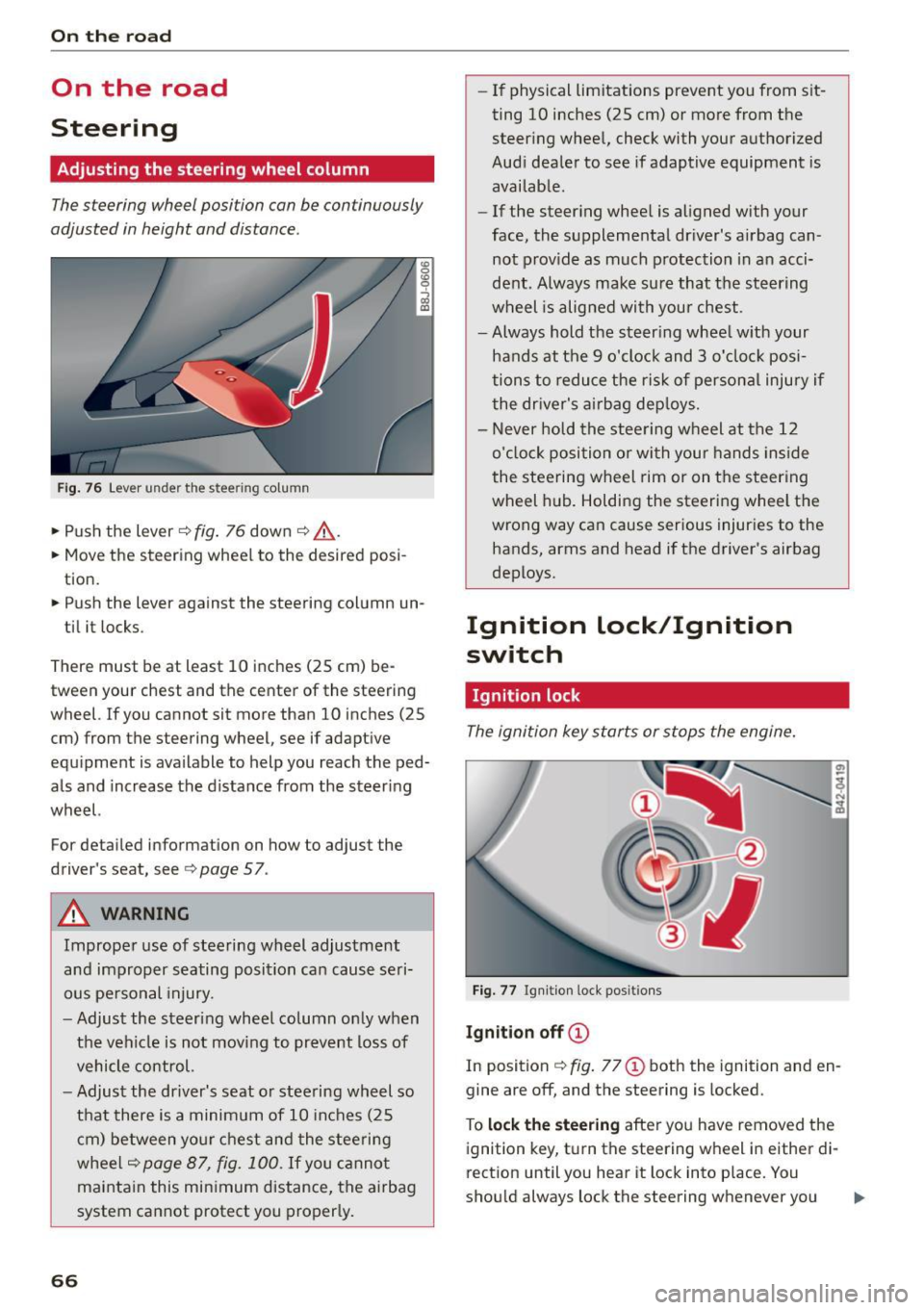
On the road
On the road
Steering
Adjusting the steering wheel column
The steering wheel position can be continuously
adjusted in height and distance .
Fig. 76 Lever u nde r the stee rin g co lumn
... Push the lever ¢ fig. 76 down ¢ _&.. .
... Move the steering wheel to the desired posi
tion .
... Push the lever against the steering column un-
til it locks .
There must be at least 10 inches (25 cm) be
tween your chest and the center of the steering
wheel. If you cannot sit more than 10 inches (25
cm) from the steering wheel, see if adaptive
equipment is ava ilable to help you reach the ped
als and increase the distance from the steering
wheel.
For detailed information on how to adjust the
driver's seat, see
¢ page 57.
A WARNING
Improper use of steering wheel adjustment
and improper seating position can cause seri
ous pe rsonal injury.
- Adjust the steering wheel column only when
the vehicle is not moving to prevent loss of
vehicle control.
- Adjust the driver's seat or stee ring wheel so
that there is a minimum of 10 inches (25
cm) between your chest and the steering
wheel¢
page 87, fig. 100. If you cannot
maintain this min imum distance, the airbag
system cannot protect you proper ly.
66
- If physical limitations prevent you from sit
ting 10 inches (25 cm) or more from the steering wheel, check with your authorized
Audi dealer to see if adaptive equipment is
available.
- If the steering wheel is aligned with your
face, the supplemental dr iver's airbag can
not p rov ide as much protection in an acci
dent. Always make sure that the steering
wheel is aligned with your chest.
- Always hold the steering wheel w ith your
hands at the 9 o'clock and 3 o'clock posi
tions to reduce the risk of persona l injury if
the dr iver's airbag dep loys.
- Never hold the steering wheel at the 12 o'clock position or with your hands inside
the steering wheel rim or on the steering
wheel h ub. Holding the steering wheel the
wrong way can cause serious injuries to the hands, arms and head if the driver's airbag
deploys.
Ignition Lock/Ignition
switch
Ignition lock
The ignition key starts or stops the engine.
Fig. 77 Ign it ion lock posit ions
Ignit ion off CD
In position ¢ fig. 77 (D both the ignition and en
gine are off, and the steering is locked.
To
l ock the steering after you have removed the
ignition key, t urn the steering wheel in either di
rection until you hear it lock into place. You
should always lock the steering whenever you .,.
Page 88 of 232
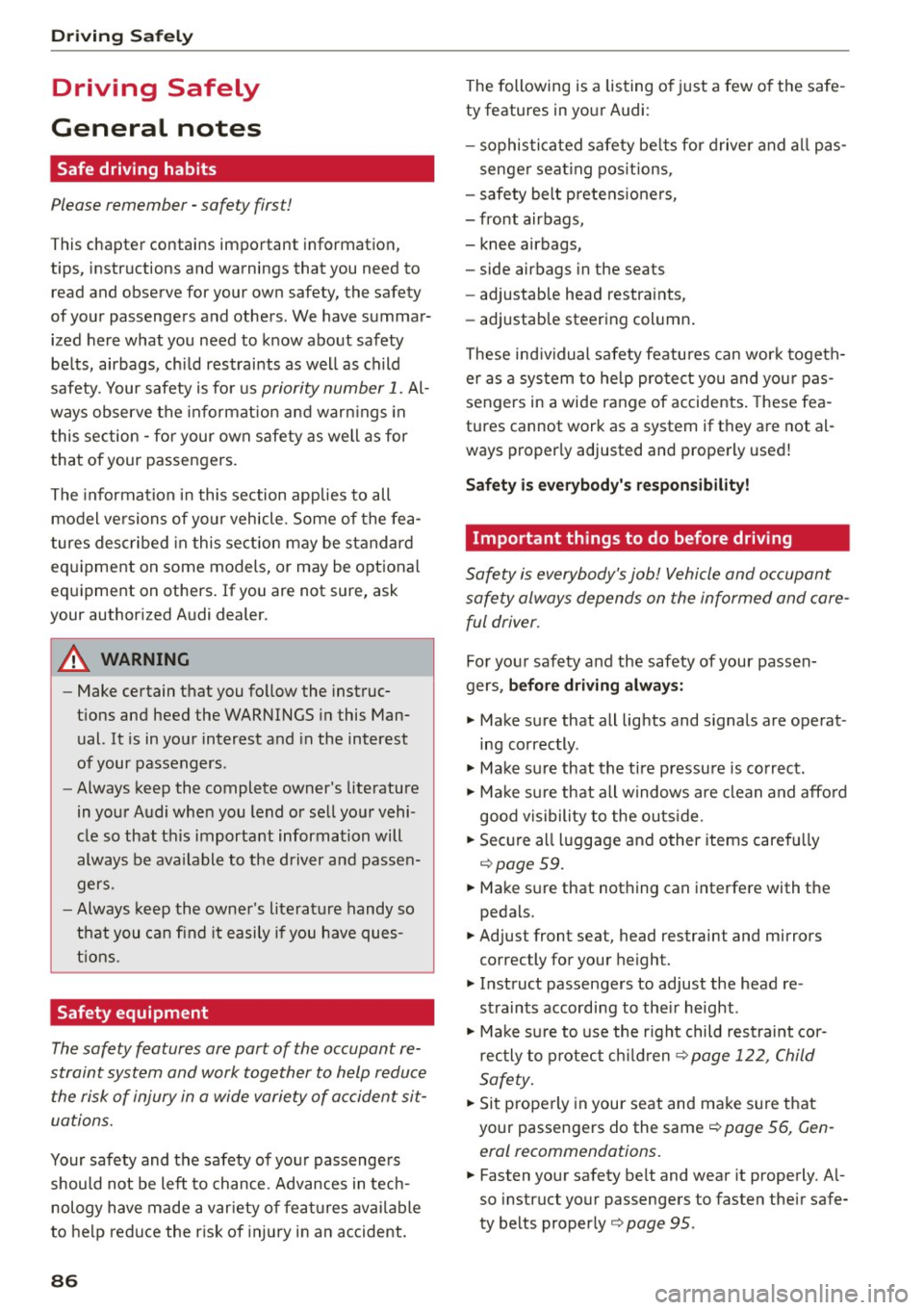
Driving Sa fel y
Driving Safely
General notes
Safe driving habits
Please remember -safety first!
This chapter contains important information,
tips, instructions and warnings that you need to
read and observe for your own safety, the safety
of your passengers and others. We have summar
ized here what you need to know about safety
be lts, airbags, chi ld restraints as well as child
safety. Your safety is for us
priority number 1 . Al
ways observe the informat ion and warn ings in
t his section - for your own safety as well as for
that of your passengers.
The information i n this section applies to all
model ve rsions of your vehicle . Some of the fea
t ures des cribed in this sect ion may be standard
equipment on some models, or may be optional
eq uipment on others . If you are not sure, ask
your author ized Audi dealer.
A WARNING
-Make certain that you fo llow the instruc
t ions and heed the WARNINGS in this Man
ual. It is in your interest and in the interest
of your passengers .
- Always keep the complete owner's literature
in your Audi when you lend or se ll you r vehi
cle so that this important information will
always be ava ilable to the driver and passen
gers.
- Always keep the owner's literature handy so
that you can find it easily if you have ques
ti ons.
Safety equipment
The safety features are part of the occupant re
straint system and work together to help reduce
the risk of injury in a wide variety of occident si t
uations.
Your safety and the safety of yo ur passengers
should not be left to chance. Advances in tec h
nology have made a var iety of f eatures av ailable
to help re duce the r isk of inj ury in an accident.
86
The following is a listing o f just a few o f the safe
ty features in yo ur Audi:
- sophis tica ted s afety be lts for drive r and a ll pas-
senger sea ting pos itions,
- safety belt p rete nsio ners,
- front airbags,
- knee airbags,
- side airbags in the seats
- adjustab le head restraints,
- adjustab le steering column .
These ind iv idual safety featu res can wor k togeth
er as a sys tem to he lp pro tect you a nd your pas
sengers in a wide range of accidents . These fea
tures cannot work as a system if th ey are not al
ways proper ly adjusted and prope rly used!
Safety i s everyb ody' s re sponsibilit y!
Important things to do before driving
Safety is everybody's job! Vehicle and occupant
safety always depends on the informed and care
ful driver.
Fo r you r safety and the safety of your passen
gers,
before driving always:
.,. Make sure that all lights and signals are operat
ing correctly .
.,. Make sure that the tire pressu re is co rrect.
.,. Ma ke s ure that all w indows are clean and affo rd
good visibility to the outs ide.
.,. Secure a ll luggage and o ther items caref ully
r=;,page 59 .
.,. Make s ure that nothing can interfere with the
pedals.
.,. Adjust front seat, head restraint and mirrors
correctly for your height.
.,. Instruct passengers to adjust the head re
straints according to the ir height .
.,. Make su re to use the r ight child restraint cor
rec tly to p rotect ch ild ren
r=;, page 122, Child
Safety.
.,. Sit p roperly in your seat and ma ke su re that
your passengers do the same
c::> page 56, Gen
eral recommendations.
.,. Fasten your safety belt and wear it properly. A l
so instruct your passengers to fasten their safe
ty belts proper ly
c::> page 95 .
Page 101 of 232
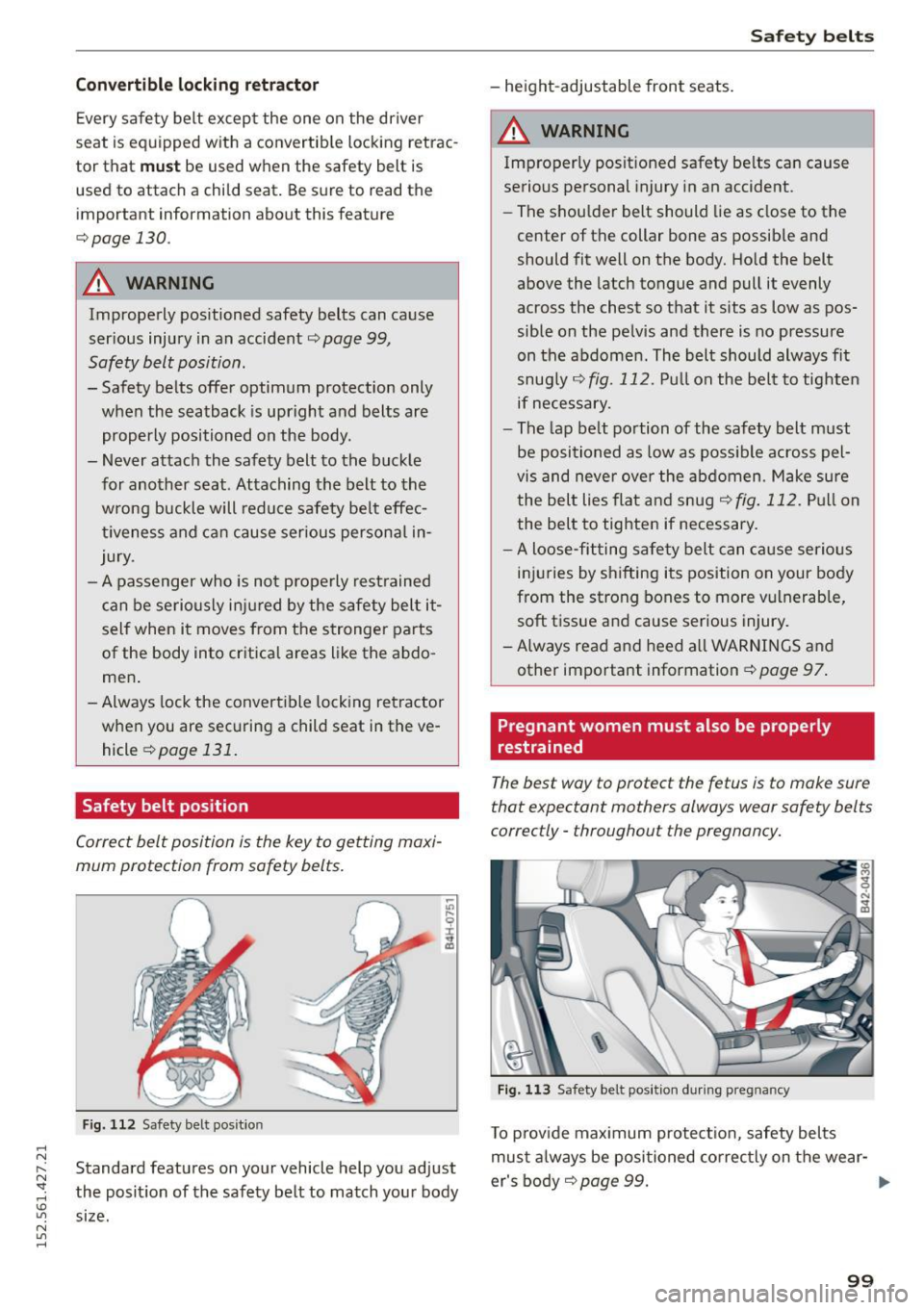
.... N
l'
N "1: rl I.O
"' N
"' ....
Convertible locking retractor
Every safety belt except the one on the driver
seat is equipped with a convertible locking retrac
tor that
must be used when the safety belt is
used to attach a child seat. Be sure to read the
important information about this feature
c::;,page 130.
A WARNING
Improperly positioned safety belts can cause
serious injury in an accident
c::;, page 99,
Safety belt position.
- Safety belts offer optimum protection only
when the seatback is upright and belts are
properly positioned on the body.
- Never attach the safety belt to the buckle
for another seat. Attaching the belt to the
wrong buckle will reduce safety belt effec
tiveness and can cause serious personal in
jury .
- A passenger who is not properly restrained
can be seriously injured by the safety belt it
self when it moves from the stronger parts
of the body into critical areas like the abdo
men .
- Always lock the convertible locking retractor
when you are securing a child seat in the ve
hicle
c::;, page 131.
Safety belt position
Correct belt position is the key to getting maxi
mum protection from safety belts.
Fig. 112 S afety be lt pos it io n
Standard features on your vehicle help you adjust
the position of the safety belt to match your body
size .
Safety belts
-height -adjustable front seats.
A WARNING
Improperly positioned safety belts can cause
serious personal injury in an accident .
- The shou lder belt should lie as close to the
center of the collar bone as possible and
should fit well on the body. Hold the belt
above the latch tongue and pull it evenly
across the chest so that it sits as low as pos
sible on the pelvis and there is no pressure
on the abdomen. The belt should always fit
snugly
<> fig. 112. Pull on the belt to tighten
if necessary.
- The lap belt portion of the safety belt must
be positioned as low as poss ible across pel
vis and never over the abdomen. Make sure
the belt lies flat and snug
c::;, fig. 112 . Pull on
the belt to tighten if necessary.
- A loose-fitting safety belt can cause serious
injuries by shifting its position on your body
from the strong bones to more vulnerable,
soft tissue and cause serious injury.
-Always read and heed all WARNINGS and
other important information
c::;, page 97 .
Pregnant women must also be properly
restrained
Th e best way to protect th e fetus is to make sure
that expectant mothers always wear safety belts
correc tly- throughout the pregnancy.
Fig. 113 Safety be lt po sition during preg nan cy
To prov ide max imum protect ion, safety belts
must a lways be positioned correctly on the wear-
er's body
r::!;>page 99. .,.
99
Page 118 of 232
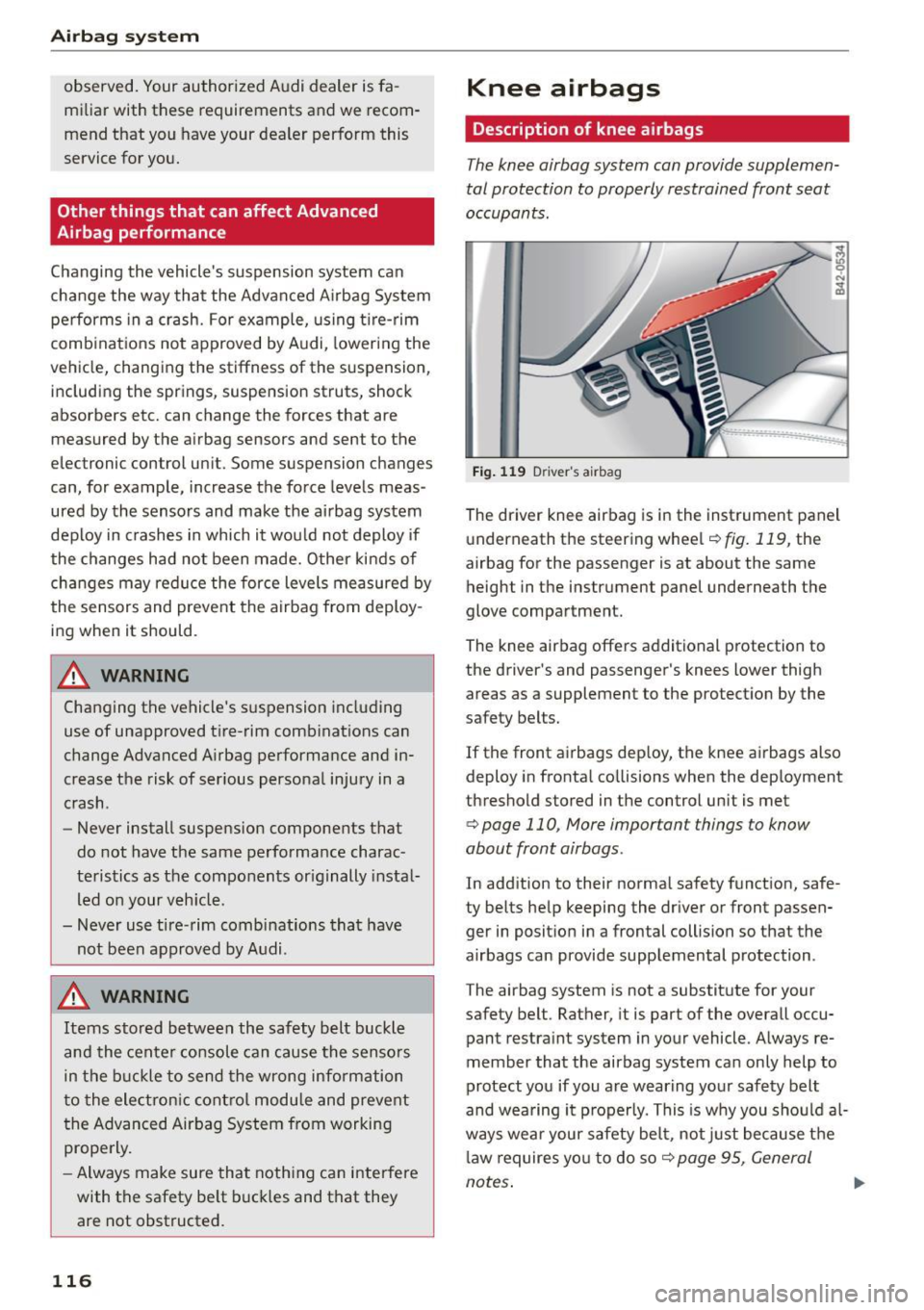
Airb ag syst em
observed. Your authorized Audi dealer is fa
miliar with these requirements and we recom
mend that you have your dealer perform this
service for you.
Other things that can affect Advanced
Airbag performance
Changing the vehicle's suspension system can
change the way that the Advanced Airbag System
pe rforms in a crash. For example, us ing t ire-rim
comb inat ions not approved by Audi, lowering the
vehicle, changing the stiffness of the suspension, including the springs, suspension struts, shock
absorbers etc. can change the forces that are measured by the airbag sensors and sent to the
electronic control unit. Some suspension changes
can, for example, increase the force levels meas
ured by the sensors and make the airbag system
deploy in crashes in which it wou ld not deploy if
the changes had not been made. Other kinds of
changes may reduce the force levels measured by
the sensors and prevent the airbag from deploy
ing when it should.
A WARNING
Changing the vehicle's s uspension including
use of unapproved t ire-rim comb inat ions can
change Advanced A irbag performance and in
crease the risk of ser ious persona l injury in a
crash .
- Never install suspension components that
do not have the same performance charac
te ristics as the components or iginally insta l
led on your veh icle.
- Never use tire-rim combinations that have not been approved by A udi.
A WARNING
Items stored between the safety belt buckle
and the center console can cause the senso rs
in the b uck le to send the wrong information
t o the electron ic contro l modu le and prevent
t he Advanced Airbag System from working
properly.
- Always make sure that nothing can interfere
with the safety be lt b uckles and that they
are not obstructed.
116
Knee airbags
Description of knee airbags
The knee airbag system can provide supplemen
tal protection to properly restrained front seat
occupants .
Fig. 119 D river 's airbag
The driver knee airbag is in the instrument panel
u nderneath the steer ing whee l
~fig. 119, the
airbag for the passenger is at about the same height in the instrument panel underneath the
glove compartment.
The knee airbag offers additional protection to
the driver's and passenger's knees lower thigh
areas as a supplement to the protection by the
safety belts.
If the front a irbags dep loy, the knee a irbags also
deploy in fronta l co llisions when the dep loyment
threshold stored in the control unit is met
~ page 110 , More important things to know
about front airbags .
In addition to their normal safety function, safe
ty belts help keeping the driver or front passen ger in posit ion in a frontal collision so that the
airbags can provide supplemental protection .
The airbag system is not a substitute for your
safety belt . Rather, it is part of the overall occu
pant restra int system in your vehicle. A lways re
member that the airbag system can only help to
protect you if you are wearing your safety belt
and wea ring it p roperly. This is why you sho uld a l
ways wear your safety be lt, not just because the
l aw requires yo u to do so¢
page 95, General
notes .
llll-
Page 173 of 232
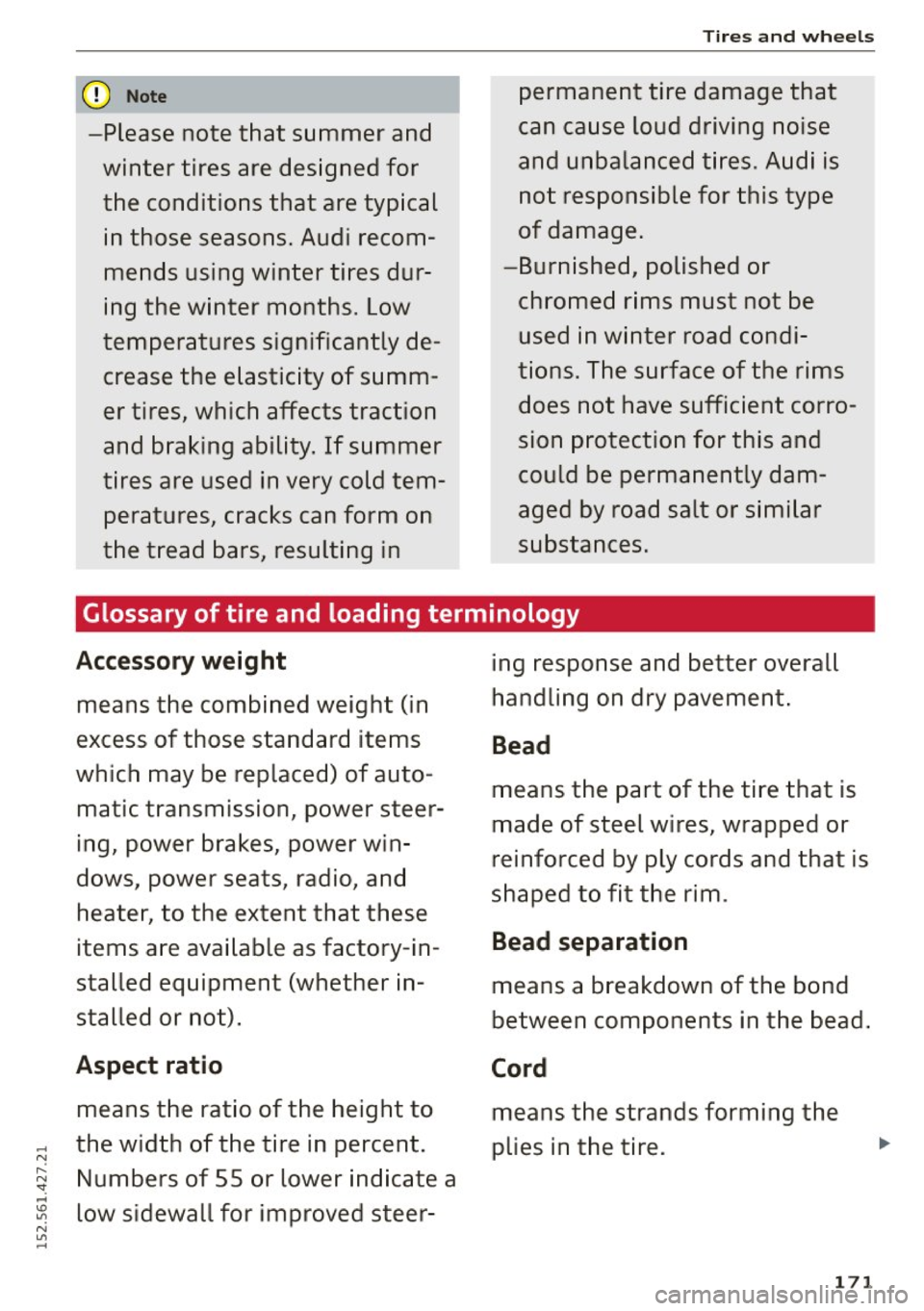
(D Note
- Please note that summer and
winter t ires are designed for
the conditions that are typical in those seasons . Audi recom
mends using winter tires dur
ing the winter months . Low
temperatures significantly de
crease the elasticity of summ
er tires, which affects traction
and braking ability. If summer
tires are used in very cold tem peratures, cracks can form on
the tread bars, resulting in
Tires and wheels
permanent tire damage that
can cause loud driving noise
and unbalanced tires . Audi is
not responsible for this type
of damage.
- Burnished, polished or
chromed rims must not be
used in winter road condi
tions . The surface of the rims
does not have sufficient corro
sion protection for this and
could be permanently dam aged by road salt or similar
substances .
Glossary of tire and loading terminology
Accessory weight
means the combined weight (in
excess of those standard items
which may be replaced) of auto
matic transmission, power steer
ing, power brakes, power win
dows , powe r seats , radio , and
heater , to the extent that these
items a re available as factory-in
stalled equipment (whether in
stalled or not).
Aspect ratio
means the ratio of the height to
;:;: the width of the tire in percent .
" ~ Numbers of 55 or lower indicate a ...
~ low sidewall for improved steer -
"' ....
ing response and better overall
handling on dry pavement.
Bead
means the part of the tire that is
made of steel wires, wrapped or
reinforced by ply cords and that is
shaped to f it the rim .
Bead separation
means a breakdown of the bond
between components in the bead .
Cord
means the strands forming the
plies in the tire.
17 1
...
Page 189 of 232
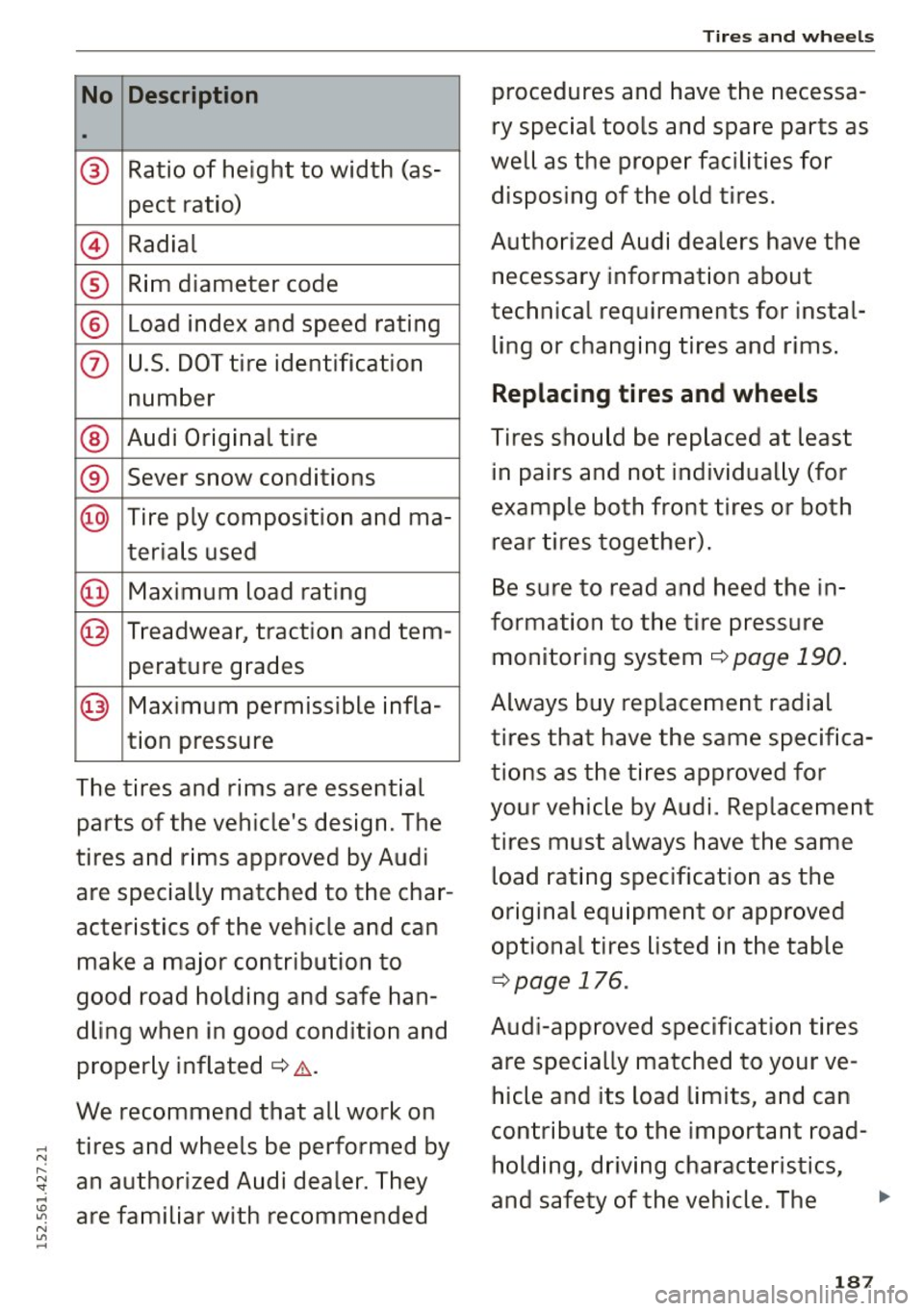
.... N
" N ": ... IO "? N
"' ....
No Descript ion
•
® Ratio of height to width (as -
pect ratio)
© Radial
® Rim diameter code
® Load index and speed rating
(j) U.S. DOT tire identification
number
® Audi Original tire
® Sever snow conditions
@ Tire ply composition and ma-
terials used
@ Maximum load rating
@ Treadwear, traction and tern-
perature grades
@ Maximum permissible infla-
tion pressure
The tires and rims are essential parts of the vehicle's design. The
tires and rims approved by Audi
are specially matched to the char
acteristics of the vehicle and can
make a major contribution to
good road holding and safe han
dling when in good condition and
properly inflated ¢
&.
We recommend that all work on
tires and wheels be performed by
an authorized Audi dealer. They
are familiar with recommended
Tires and wheels
procedures and have the necessa
ry special too ls and spare parts as
well as the proper facilities for
disposing of the old ti res.
Authorized Audi dealers have the necessary information about
technical requirements for insta l
ling or changing tires and rims.
Replacing tire s and wheel s
Tires should be replaced at least
in pairs and not individually (for
example both front tires or both rear tires together).
Be sure to read and heed the in
formation to the tire pressure
monitoring system¢
page 190.
Always buy replacement radial
tires that have the same specifica
tions as the tires approved for
your vehicle by Audi . Replacement
tires must always have the same
load rating specification as the
original equipment or approved
optional tires listed in the table
i=> page 176 .
Audi-approved specification tires
are specially matched to your ve
hicle and its load limits, and can
contribute to the important road holding, driving characteristics,
and safety of the vehicle. The .,.
187
Page 190 of 232
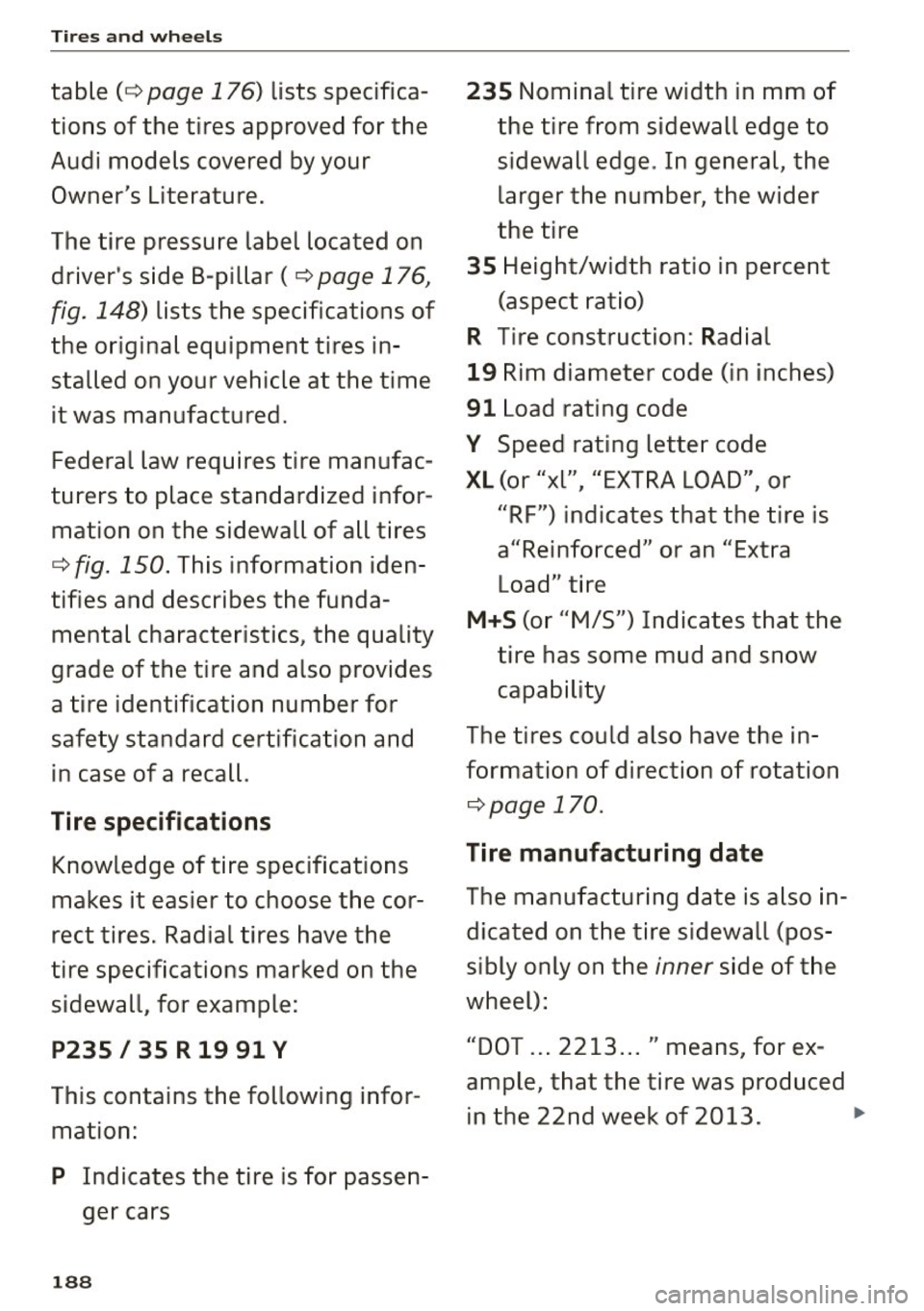
Tires and wheels
table( ¢ page 176) lists specifica
tions of the tires approved for the
Audi models covered by your
Owner's Literature.
The tire pressure label located on driver's s ide 8-pillar
(¢page 176,
fig. 148) lists the specifications of
the original equipment tires in
stalled on your vehicle at the time
it was manufactured.
Federal law requires tire manufac
turers to place standardized infor
mation on the sidewall of all tires
¢ fig .
150 . This information iden
tifies and describes the funda
mental characteristics, the quality
grade of the tire and also provides
a tire identification number for
safety standard certification and in case of a recall.
Tire specifications
Knowledge of tire spec ifications
makes it easier to choose the cor
rect tires. Radial tires have the
tire specifications marked on the
sidewall, for example:
P235 / 35 R 19 91 Y
This contains the following infor
mation:
P I ndicates the tire is for passen
ger cars
1 88
235 Nominal tire width in mm of
the tire from sidewall edge to
sidewall edge . In general, the
larger the numbe r, the wide r
the tire
35 Height/width ratio in percent
(aspect ratio)
R Tire construction: Radial
19 Rim diameter code (in inches)
91 Load rating code
Y Speed rating letter code
XL (or "xl", "EXTRA LOAD", or
"RF") indicates that the tire is
a"Reinforced" or an "Ext ra
Load" ti re
M+S (o r "M/S") Indicates that the
tire has some mud and sn ow
capability
The tires could also have the in
formation of direction of rotation
¢page 170.
Tire manufacturing date
The manufactur ing date is a lso in
dicated on the tire sidewa ll (pos
sibly only on the
inner side of the
wheel) :
"DOT .. . 2213 ... "means, for ex
ample, that the tire was produced in the 22nd week of 2013. .,.
Page 197 of 232
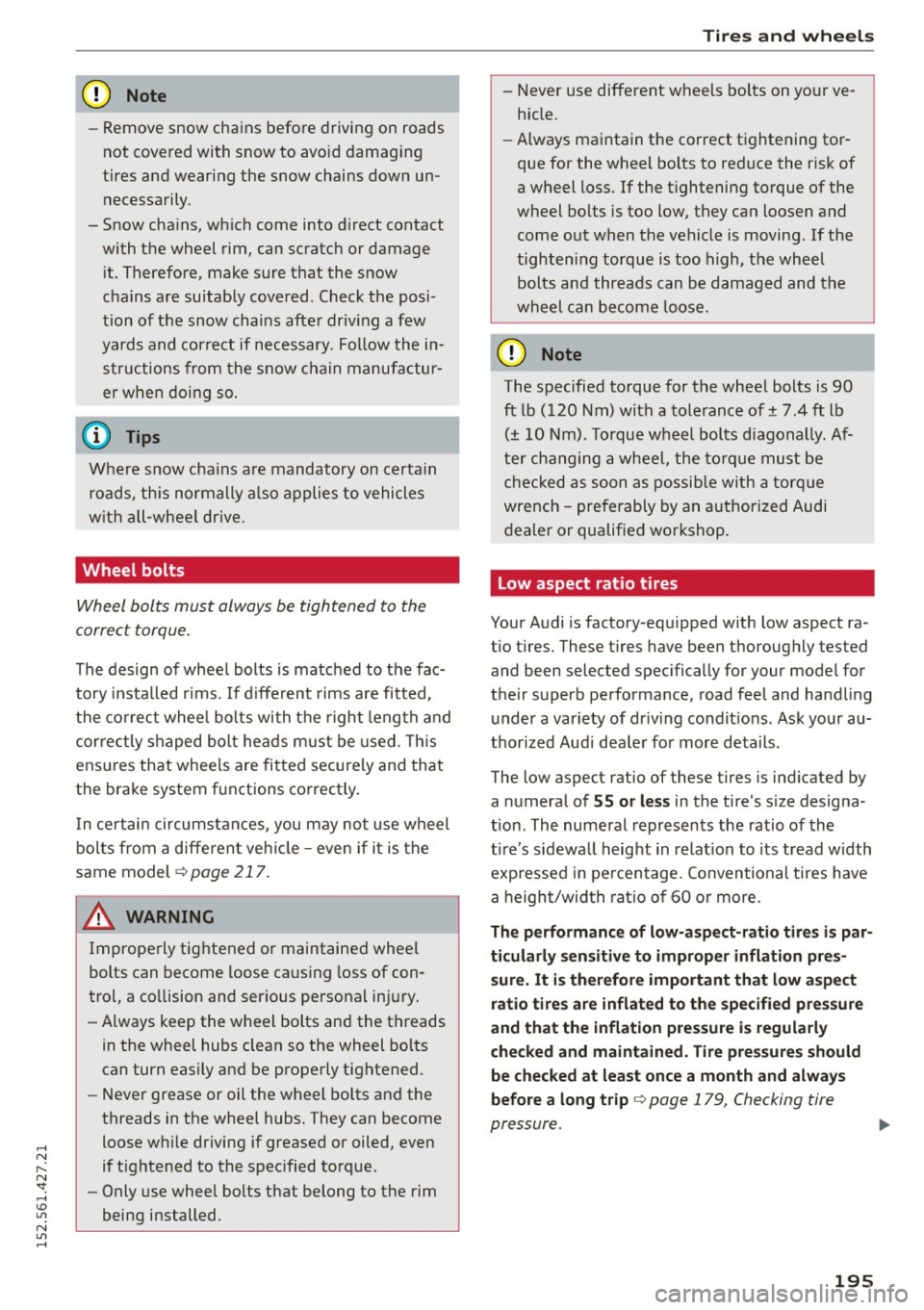
..... N
r-N "': ..... \!) 1.1'1
N 1.1'1 .....
CD Note
-Remove snow chains before driving on roads
not covered with snow to avoid damaging
tires and wearing the snow chains down un necessarily.
- Snow chains, which come into direct contact
with the wheel rim, can scratch or damage
it. Therefore, make sure that the snow
chains are suitably covered . Check the posi
tion of the snow chains after driving a few
yards and correct if necessary. Follow the in
structions from the snow chain manufactur
er when doing so.
(j) Tips
Where snow chains are mandatory on certain
roads, this normally also applies to vehicles
with all-wheel drive.
Wheel bolts
Wheel bolts must always be tightened to the
correct torque .
The design of wheel bolts is matched to the fac
tory installed rims. If different rims are fitted,
the correct wheel bolts with the right length and
correctly shaped bolt heads must be used. This
ensures that wheels are fitted securely and that
the brake system functions correctly.
In certain circumstances, you may not use wheel
bolts from a different vehicle -even if it is the
same model ¢
page 217.
A WARNING
Improperly tightened or maintained wheel
bolts can become loose causing loss of con
trol, a collision and serious personal injury.
-
- Always keep the wheel bolts and the threads
in the wheel hubs clean so the wheel bolts
can turn easily and be properly tightened.
- Never grease or oil the wheel bolts and the
threads in the wheel hubs. They can become
loose while driving if greased or oiled, even
if tightened to the specified torque.
- Only use wheel bolts that belong to the rim
being installed.
Tires and wheels
- Never use different wheels bolts on your ve
hicle.
- Always maintain the correct tightening tor
que for the wheel bolts to reduce the risk of
a wheel loss. If the tightening torque of the
wheel bolts is too low, they can loosen and
come out when the vehicle is moving. If the
tightening torque is too high, the wheel bolts and threads can be damaged and the
wheel can become loose.
CD Note
The specified torque for the wheel bolts is 90
ft lb (120 Nm) with a tolerance of± 7 .4 ft lb
(± 10 Nm) . Torque wheel bolts diagonally. Af
ter changing a wheel, the torque must be
checked as soon as possible with a torque
wrench -preferably by an authorized Audi
dealer or qualified workshop.
Low aspect ratio tires
Your Audi is factory-equipped with low aspect ra
tio tires. These tires have been thoroughly tested
and been selected specifically for your model for
their superb performance, road feel and handling under a variety of driving conditions . Ask your au
thorized Audi dealer for more details.
The low aspect ratio of these tires is indicated by
a numeral of
55 or less in the tire's size designa
tion. The numeral represents the ratio of the
tire's sidewall height in relation to its tread width
expressed in percentage. Conventional tires have
a height/width ratio of 60 or more.
The performance of low-aspect-ratio tires is par
ticularly sensitive to improper inflation pres
sure. It is therefore important that low aspect
ratio tires are inflated to the specified pressure
and that the inflation pressure is regularly
checked and maintained. Tire pressures should be checked at least once a month and always
before a long trip
c> page 179, Checking tire
pressure.
195